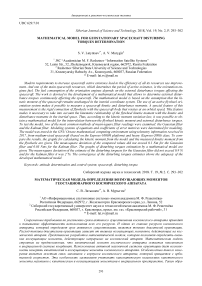Mathematical model for geostationary spacecraft disturbing torques determination
Автор: Latyntsev S.V., Murygin A.V.
Журнал: Сибирский аэрокосмический журнал @vestnik-sibsau
Рубрика: Авиационная и ракетно-космическая техника
Статья в выпуске: 2 т.19, 2018 года.
Бесплатный доступ
Modern requirements to increase spacecraft active existence lead to the efficiency of all its resources use improve- ment. And one of the main spacecraft resources, which determines the period of active existence, is the orientation en- gines fuel. The fuel consumption of the orientation engines depends on the external disturbance torques affecting the spacecraft. The work is devoted to the development of a mathematical model that allows to determine external distur- bance torques continuously affecting the spacecraft. The mathematical model is based on the assumption that the ki- netic moment of the spacecraft remains unchanged in the inertial coordinate system. The use of an active flywheel ori- entation system makes it possible to measure a spacecraft kinetic and disturbance moments. A special feature of this measurement is the rigid connection of flywheels with the spacecraft body that rotates at an orbital speed. This feature makes it necessary to take into account the kinematic relationship of the flywheel kinetic moment with the kinetic and disturbance moments in the inertial space. Thus, according to the kinetic moment variation law, it was possible to ob- tain a mathematical model for the interrelation between the flywheel kinetic moment and external disturbance torques. To test the model, two of the most common methods of mean-square filter readings were examined: the Gaussian filter and the Kalman filter. Modeling systems of equations and coefficients of error matrices were determined for modeling. The model was tested in the GNU Octave mathematical computing environment using telemetry information received in 2017, from medium-sized spacecraft (based on the Express-1000H platform) and heavy (Express-2000) class. To com- pare the results, the graphs for calculating the kinetic moment from the model and the measured kinetic moment from the flywheels are given. The mean-square deviation of the compared values did not exceed 0.1 Nm for the Gaussian filter and 0.03 Nms for the Kalman filter. The graphs of disturbing torques estimation by a mathematical model are given. The mean-square deviation of the estimate of the disturbing torquess for the Gaussian filter did not exceed 0.9 % and for the Kalman filter it was 2 %. The convergence of the disturbing torques estimates shows the adequacy of the developed mathematical model.
Attitude determination and control system, spacecraft, disturbing torque
Короткий адрес: https://sciup.org/148321841
IDR: 148321841 | УДК: 629.7.01 | DOI: 10.31772/2587-6066-2018-19-2-293-302
Список литературы Mathematical model for geostationary spacecraft disturbing torques determination
- Раушенбах Б. В., Токарь Е. Н. Управление ориентацией космических аппаратов. М.: Наука, 1974. 600 с.
- Hughes P. C. Spacecraft attitude dynamics. New York: Dover publications Inc., 2004. 570 p.
- Sidi M. J. Spacecraft dynamics and control. Cambridge: Cambridge Univercity Press, 2002. 409 p.
- Wertz J. R. Spacecraft Attitude determination and control. London: Dordrecht/Boston, 1990. 863 p.
- Математическая модель управляемого углового движения наноспутника с инерционными исполнительными органами / М. М. Молдабеков [и др.] // Вестник Самарского государственного аэрокосмического университета. 2016. № 1 (15). С. 97-106.


